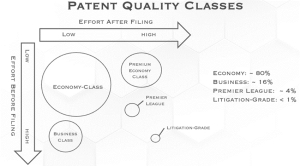- in Asia
- in Asia
- with readers working within the Technology, Media & Information and Pharmaceuticals & BioTech industries
Wow – we've just wrapped up the 10th edition of our "Generative AI/Robot Patent Drafting Workshop," and the response was overwhelming! Our servers broke down due to the high demand, a clear reminder that AI-assisted patent drafting isn't just a buzzword – it's the future of IP.
In today's fast-paced IP landscape, efficiency is everything. This workshop focused on how AI tools are transforming repetitive, time-intensive patent drafting tasks, enabling professionals to focus on the strategic elements that add real value. Our goal? Achieve up to 50%-time savings using patent drafting robots paired with our unique workflow.
Key Takeaways from Our Hands-On Workshop:
1. Faster, High-Quality Patent Drafts with Qatent
Robot
Participants dove into the powerful Qatent robot, a game-changer
from Questel designed specifically for EP-style patent drafting.
Qatent automates every step – from invention disclosure to
final application review – making it an excellent fit for
"economy-class" patents that need efficient yet
high-quality drafting. The robot reformulates claims into clear,
natural language, aligning with standards for EPO and SIPO filings,
and turning complex ideas into understandable, structured
sections.
2. Quality of Input Equals Quality of
Output
One of our core lessons: "Garbage in, garbage out." For
AI-generated drafts to reach their potential, quality input is
non-negotiable. Participants learned how to structure disclosures
effectively to maximize the accuracy and completeness of AI output.
This input workflow is crucial for achieving high-quality drafts
with minimal human adjustment.
3. Patent Quality Grades Framework: Match Quality to
Project Needs
A key insight was the "patent quality grades" framework,
which introduces economy, business, and litigation-grade patents.
Each grade requires different levels of preparation and oversight.
Economy-grade drafts benefit most from AI efficiency, while
litigation-grade patents still require substantial human expertise.
This framework allows IP professionals to tailor AI's role
based on project needs, making it a powerful strategy tool.

4. Technical and Practical Challenges: Overcoming AI
Integration Hurdles
Working with AI isn't always smooth sailing –
adaptability is crucial. Participants gained insight into the
real-world technical and practical challenges of integrating AI,
from training models to managing exceptions. The workshop prepared
attendees to anticipate and troubleshoot these issues, ensuring a
seamless AI drafting process.
5. Compliance and Data Privacy: On-Premises vs.
Cloud-Based Solutions
Data security is critical, especially with sensitive patent data.
We explored best practices for choosing between on-premises and
cloud solutions based on compliance needs. On-premises setups offer
high control and are ideal for firms with strict compliance
standards, while cloud-based tools provide scalability. However,
GDPR-compliant providers are essential for any web-based
solution.
- Key Considerations:
- Data Sensitivity: On-premises is safer for sensitive data.
- Regulatory Compliance: Verify GDPR or CCPA alignment.
- Data Control & Encryption: Ensure strong ownership, control, and end-to-end encryption.
- User Access & Audits: Implement secure access controls and regular logging.
Curious to See What's Possible? Join Us for the Next Workshop!
This workshop pushed boundaries and showcased how AI can revolutionize patent drafting while maintaining the highest standards. Our participants left inspired and equipped with tools and knowledge to enhance their daily workflows – are you ready to take the next step? Don't miss out on the next workshop!
Gain hands-on experience, see the latest AI innovations in action, and unlock efficiency like never before. "The 11th Generative AI/Robot Patent Drafting Workshop" will return in January 2025.
IP Lawyer Tools by Martin Schweiger
The content of this article is intended to provide a general guide to the subject matter. Specialist advice should be sought about your specific circumstances.

